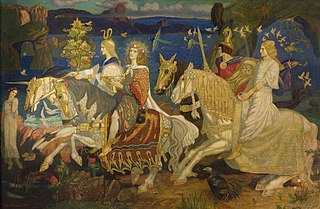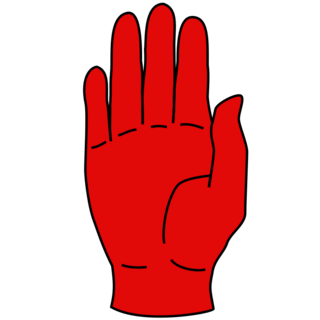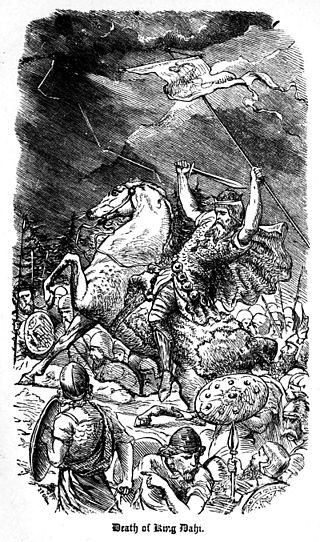Related Research Articles

Irish mythology is the body of myths indigenous to the island of Ireland. It was originally passed down orally in the prehistoric era. In the early medieval era, some myths were transcribed by Christian monks, who heavily altered and Christianised the myths. Irish mythology is the best-preserved branch of Celtic mythology.

Lebor Gabála Érenn is a collection of poems and prose narratives in the Irish language intended to be a history of Ireland and the Irish from the creation of the world to the Middle Ages. There are a number of versions, the earliest of which was compiled by an anonymous writer in the 11th century. It synthesised narratives that had been developing over the foregoing centuries. The Lebor Gabála tells of Ireland being settled six times by six groups of people: the people of Cessair, the people of Partholón, the people of Nemed, the Fir Bolg, the Tuatha Dé Danann, and the Milesians. The first four groups are wiped out or forced to abandon the island; the fifth group represents Ireland's pagan gods, while the final group represents the Irish people.

Niall Noígíallach, or Niall of the Nine Hostages, was a legendary, semi-historical Irish king who was the ancestor of the Uí Néill dynasties that dominated Ireland from the 6th to the 10th centuries. Historical Irish annalistic and chronicle sources place his reign in the late 4th and early 5th centuries, although modern scholars date him about half a century later.

The Delbna or Delbhna were a Gaelic Irish tribe in Ireland, claiming kinship with the Dál gCais, through descent from Dealbhna son of Cas. Originally one large population, they had a number of branches in Connacht, Meath, and Munster in Ireland.
Lugaid Mac Con, often known simply as Mac Con, was, according to medieval Irish legend and historical tradition, a High King of Ireland. He belonged to the Corcu Loígde, and thus to the Dáirine. His father was Macnia mac Lugdach, and his mother was Sadb ingen Chuinn, daughter of the former High King Conn Cétchathach. Mac Con may be to some extent identical with another legendary King of Tara from the Dáirine, Lugaid Loígde.

Nath Í, also known as Dathí, son of Fiachrae, son of Eochaid Mugmedon, was a semi-historical Irish king of the 5th century, the father of the likely-historical king Ailill Molt and the ancestor of the Uí Fiachrach dynasties of early medieval Connacht. His mother was Béḃinn. According to legend, he was a High King of Ireland, and died after being struck by lightning while on an expedition to the Alps.

The Book of Leinster is a medieval Irish manuscript compiled c. 1160 and now kept in Trinity College Dublin, under the shelfmark MS H 2.18. It was formerly known as the Lebor na Nuachongbála "Book of Nuachongbáil", a monastic site known today as Oughaval.
A number of Irish annals, of which the earliest was the Chronicle of Ireland, were compiled up to and shortly after the end of the 17th century. Annals were originally a means by which monks determined the yearly chronology of feast days. Over time, the obituaries of priests, abbots and bishops were added, along with those of notable political events. Non-Irish models include Bede's Chronica maiora, Marcellinus Comes's Chronicle of Marcellinus and the Liber pontificalis. Most of the Irish annals were written between the 14th and 17th centuries.

The Book of Ballymote, was written in 1390 or 1391 in or near the town of Ballymote, now in County Sligo, but then in the tuath of Corann.

John O'Donovan, from Atateemore, in the parish of Kilcolumb, County Kilkenny, and educated at Hunt's Academy, Waterford, was an Irish language scholar from Ireland.
Togail Bruidne Dá Derga is an Irish tale belonging to the Ulster Cycle of Irish mythology. It survives in three Old and Middle Irish recensions, it is part of the Book of Dun Cow. It recounts the birth, life, and death of Conaire Mór son of Eterscél Mór, a legendary High King of Ireland, who is killed at Da Derga's hostel by his enemies when he breaks his geasa. It is considered one of the finest Irish sagas of the early period, comparable to the better-known Táin Bó Cúailnge.
Dartraighe, anglicised as Dartree, Dartry or Dartrey, was an Irish territory or tuath in medieval Ireland which stretched north to Clones and south to the Dromore River. It was later incorporated into County Monaghan as the barony of Dartree.
Cín Dromma Snechtai or Lebor Dromma Snechtai is a now lost early Irish manuscript, thought to have been written in the 8th century AD.
Flann Mainistrech was an Irish poet and historian.
Senchas Fagbála Caisil "The Story of the Finding of Cashel" is an early medieval Irish text which relates, in two variants, the origin legend of the kingship of Cashel. Myles Dillon has dated the first variant to the 8th century, and the second tentatively to the 10th century.

Myles Patrick Dillon was an Irish scholar whose primary interests were comparative philology, Celtic studies, and Sanskrit.
Irish genealogy is the study of individuals and families who originated on the island of Ireland.
Leabhar Ua Maine is an Irish genealogical compilation, created c. 1392–94.
Loígis is the name of an Irish tribe, as it is called by contemporary scholars. Formerly, scholars generally called the tribe Laoighis or Laeighis in Irish, Lagisia in Latin, and Leix in English. Loígis is also the name of the territory in western Leinster that the tribe settled during the third century AD, and of the minor kingdom that the Loígis chieftains ruled until 1608. County Laois derives its name from Loígis, although the present county encompasses baronies that were not traditionally part of the territory of Loígis.
Mullaghreelan Rath is a ringfort (rath) and National Monument located in County Kildare, Ireland.
References
- ↑ Welch, Robert (2000). The Concise Oxford Companion to Irish Literature . Oxford University Press. p. 34. ISBN 9780192800800.
- ↑ Full text of "Lebor na cert = The Book of rights".
- ↑ 'Lebor na gCeart' - The 'Book of Rights'.
- ↑ John O'Donovan, The Book of Rights (Celtic society, 1847) page vi.
- ↑ O'Donovan, John (ed. and tr.), Leabhar na g-Ceart, or the Book of rights, Dublin: Celtic Society, 1847.
- ↑ Book of Rights (Introduction).
Sources
- O'Donovan, John, ed. (1847), Leabhar na gCeart, or The Book or Rights, translated by O'Donovan, John, The Celtic Society
- Dillon, Myles (1962), Lebor na Cert: The Book of Rights, Irish Texts Society
- Dillon, Myles (ed.), "Lebor na Cert", Corpus of Electronic Texts (digital edition)